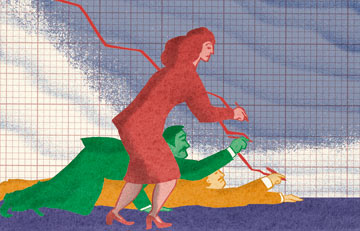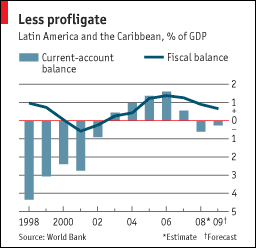
(above) Illustration by S. Kambayashi
Preparing for tougher times
December 11, 2008 - The Economist print edition
There is much that governments can do to protect recent social gains -- but they will need outside help
IT WAS great while it lasted. In the five years from 2004 Latin America's economies grew at an annual average rate of over 5%, inflation remained generally low, credit expanded and exports boomed. All this meant that the proportion of people living in poverty fell from 44% in 2002 to 33% this year, according to an estimate this week by the United Nations Economic Commission for Latin America and the Caribbean. Now the task facing the region's policymakers is to limit the damage as the world economy deflates.
Until September Latin Americans could still hope that they would escape the worst of the downturn. Brazil's economy, for example, grew by 6.8% in the third quarter compared with the same period last year, while Peru's GDP expanded by 10% in the year to September. But in the past two months, Latin America has seen its stockmarkets crash, currencies wobble and credit start to dry up. That comes on top of falling exports and the plunge in the prices of the commodities it sells to the world. Twisting the knife, less money is being sent home by Latin Americans working abroad (see article).
This has sent economists scurrying to cut their forecasts time and again. As recently as October, the IMF expected growth in the region next year of 3.2%. This week the World Bank forecast 2.1%. The same day Morgan Stanley, an investment bank whose Latin American research team is among the more pessimistic about the region, cut its forecast for the seven largest economies in 2009 from growth of 1.5% to a contraction of 0.4%.
The average conceals wide variations. Brazil's government still expects growth of 4% next year, though that looks optimistic. Mexico, hit by its close ties to the American economy, will be worse affected, but may manage growth of 0.4%, according to a poll of private forecasters by its central bank.
Two things lie behind the bleaker outlook. The first is the continuing steep fall in commodity prices because of worries that China's economy is stalling. Commodities, from Venezuelan oil to Peruvian minerals, Argentine soya and Brazilian iron ore and orange juice, make up a big chunk of the region's exports.
The second dampener is that banks in Latin America have turned cautious. Many foreign banks are cancelling credit lines to the region, or renewing them for shorter periods or at higher rates. That may be to shore up their battered finances at home, but local banks seem to be following suit. "What's new is that until recently credit was seen as a shock absorber. We're discovering that the link between the world and Latin America is still very strong," says Gray Newman of Morgan Stanley. As investors flee risk, financing conditions for governments have tightened too.
As they watch governments from Australia to the United States throw the kitchen sink at their economies to try to jolt them into life, the question for Latin American policymakers is whether they can afford to do something similar.
 The answer is maybe. Many of the larger economies are entering the slowdown with stronger fiscal and balance-of-payments positions than in the past (see chart). That is a tribute to lessons learnt the hard way. Governments have slimmed their debt and shifted much of it into local currency, so at least currency weakening does not automatically increase the fiscal burden. Unlike their peers in the rich countries, many of the region's central banks raised their benchmark interest rates earlier this year as higher food and fuel prices caused inflation to spike.
The answer is maybe. Many of the larger economies are entering the slowdown with stronger fiscal and balance-of-payments positions than in the past (see chart). That is a tribute to lessons learnt the hard way. Governments have slimmed their debt and shifted much of it into local currency, so at least currency weakening does not automatically increase the fiscal burden. Unlike their peers in the rich countries, many of the region's central banks raised their benchmark interest rates earlier this year as higher food and fuel prices caused inflation to spike.
But even if on paper there is scope for counter-cyclical policies, in practice there are still constraints (see article). Though monetary policy in many countries is governed by inflation targets, central bankers must keep a weather eye on the currency. Despite the region's new-found strengths, Latin America is paying for the sins of the past; at the first sign of instability people dump local currencies and buy dollars in a "Pavlovian reaction", says Damian Fraser of UBS, an investment bank. Even so, several central banks have kept rates steady, rather than raising them, even as currencies slipped. As commodity prices fall and growth slows, inflation should fall and interest-rate cuts should follow next year. Whether they will boost credit is not clear.
The scope for governments safely to spend their way back to higher growth is also limited. Chile is the big exception, having saved $21 billion derived mainly from windfall copper revenues in reserve funds. Its government has unveiled stimulus measures worth $2 billion, including credit lines for small and medium business and, less sensibly, sectoral bail-outs for salmon farmers and housebuilders. On a smaller scale Peru and Mexico have scope to step up public spending. In Mexico's case, that is thanks partly to nifty hedging of its oil exports -- earlier this year it presold much of next year's oil output at an average price of $70 per barrel. That may have gained it around $7.5 billion, or almost 1% of GDP, to invest in infrastructure.
Elsewhere, governments will be constrained by falling tax revenues. Brazil's is committed to a primary fiscal surplus (ie, before debt payments) of 3.8% of GDP in order to continue to lighten its debt burden. If it lowers that target, it may compromise the Central Bank's ability to cut its benchmark rate (currently a stiff 13.75%) next year. Worse off are countries such as Venezuela and to a lesser extent Argentina that have squandered much of their commodity boom. The World Bank expects both to grow less than the regional average next year, while Morgan Stanley expects contractions of 1% and 2.2% respectively.
The best that fiscal policy may be able to achieve is to maintain the current level of spending in the face of falling tax revenues, says Augusto de la Torre, the World Bank's chief economist for Latin America. Santiago Levy, his counterpart at the Inter-American Development Bank (IDB), thinks that governments need to start reconfiguring spending to protect the social gains of the past five years. Since few Latin Americans are covered by unemployment insurance this could include training for laid-off workers and temporary employment schemes, such as repairing rural roads. Health care will need boosting, because some Latin Americans will be unable to renew private health insurance. While most of the poorest are nowadays covered by government cash-transfer programmes, those in the third to the fifth deciles of income distribution are now at risk of falling into poverty, Mr Levy says.
In the past few years, the World Bank, the IDB and the IMF have had little work to do in Latin America because governments could raise money in the capital markets. That has changed. All three have unrolled new emergency loan facilities with few strings. In particular, governments could turn to them for credit lines for small and medium companies now threatened by the credit drought. The recent expansion of credit to such companies has helped to boost formal employment and shrink the informal economy, especially in Brazil. This trend now risks reversal.
Most forecasters expect Latin America to bounce back in 2010. Perhaps the biggest risk in the region is of abandoning the recent commitment to prudence. That has never been universal, as Argentina's recent nationalisation of private pension funds showed. It would be tragic if a slowdown triggered by outside events led Latin America to throw away the economic stability it has worked so hard to achieve.